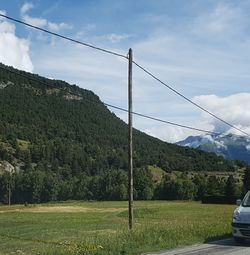Tag:power=cable
| Description |
|---|
| An insulated cable carrying electrical power, such as transmission or distribution cables located underground and undersea cables |
| Group: power |
| Used on these elements |
| Useful combination |
| See also |
| Status: de facto |
| Tools for this tag |
|
A power cable (IEC 461-06-01) is an insulated electrical power conductor, used for power transmission or distribution in complex environments such as indoors, underground or undersea.
- For large overhead power lines, mainly part of transmission networks and usually supported by towers, see power=line.
- For smaller power lines (from mains voltage to about 45 kV, depending on the country or area), usually carried on poles, use power=minor_line.
- For cables used to carry data or voice, see communication=line.
How to map
Draw a line along the feature path and tag it with power=cable. By default, cables are assumed to be buried underground or underwater and location=* can be used with appropriate value.
- Optionally add layer=* if needed to indicate the relative vertical alignment of different features.
- For cables mounted inside a man accessible self-supporting tunnel use tunnel=yes. Dedicated and accessible power tunnels are sometimes found in large cities like London
Cables, as power lines, are physical features mapped as ways which don't represent the flow of power.
- It is recommended, if known, to cut ways as often as cables are joined together. It is important to document differences (diameter, material and so on) between cable sections.
- Cables - like power lines - can be members of route=power relations corresponding to a whole power circuit between two substations.
Tagging
Much of the tagging for power=cable is identical to that for power=line, so it's a good idea to familiarise yourself with the information on that page as well.
| Key | Value | Comment | Recommendation |
|---|---|---|---|
| power | cable | It's a power cable, normally mapped as a |
Mandatory |
| voltage | <operating voltage> | The voltage at which the cable is operated | Recommended |
| location | <location> | The physical location of the cable, such as underground. See below for possible values. The default value is underground | Recommended |
| cables | <number of cables> | The number of different phase conductors for this power cable section | Recommended |
| circuits | <number of circuits> | The number of different and separated electrical circuits built within this cable section | Recommended |
| operator operator:wikidata |
<cable operator> | The name of the company which operates this power cable section | Recommended |
| owner owner:wikidata |
<cable owner> | The name of the organization that owns the cable | Optional |
| frequency | <operating frequency> | The frequency given in Hertz at which the power cable is operating | Optional |
| name | <name> | The name of this power cable section. | Optional |
| ref | <reference> | The reference of this power cable section | Optional |
Location
| Key | Value | Comment |
|---|---|---|
| location | underground | A cable buried underground (below terrestrial ground or undersea) going through ducts or not. This is the default value. |
| indoor | A power cable located inside a building or a way larger underground infrastructure | |
| underwater | A power cable located on the sea/river/lake floor, which can be seen when diving without digging soil. | |
| overground | A cable installed on the ground (it is possible since power cables are properly insulated and it makes the main difference with power lines). | |
| overhead | A cable installed on poles. They can be seen in forests or narrow environments. This makes a strong difference with uninsulated power lines, more vulnerable to climate impacts. |
location:transition=yes may be used on nodes connecting two different cable sections with different location=*s. It is even better on the end node of a power line or cable disappearing underground without more knowledge.
How to detect an underground cable
Common tagging mistakes
Examples
| Photo | Location | Tagging | Note |
|---|---|---|---|
| Germany | voltage=380000 cables=6 circuits=2 tunnel=yes location=underground |
Two circuits power cable installed in a tunnel in the Berlin underground | |
| France | voltage=220 cables=2 location=overhead |
Overhead cables suspended on wooden poles |
Rendering
Power cables aren't shown on OSM Carto and the following services are available:
- Open Infrastructure Map
- Power Grid Map
- Electricity grid map (Europe only)
- Maperitive power line rule set for rendering power lines, cables and substations in Maperitive.
See also
- Power_networks and associated local projects.
- Power transmission refinement proposal











